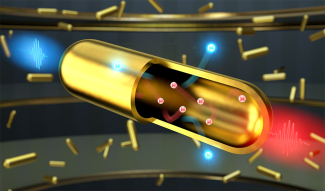In a new ACS Nano paper, JILA and NIST Fellow David Nesbitt, along with former graduate student Jacob Pettine and other collaborators, developed a new method for measuring the dynamics of specific particles known as “hot carriers,” as a function of both time and energy, unveiling detailed information that can be used to improve collection efficiencies.
Within nanoscience, gold nanoparticles have emerged as fascinating building blocks for numerous applications, ranging from catalysis and sensing to biomedicine. Among their remarkable properties is the ability to generate large numbers of “hot carriers” upon light absorption. Hot carriers refer to highly energetic charge carriers, such as electrons, which bounce around inside the gold nanoparticles. If the kinetic energy stored in these hot carriers could be fully collected, it would lead to significant efficiency boosts and new capabilities in photovoltaics, photochemical catalysis, nanophotonics, and nanoelectronics.
Hot carriers can be collected for energy harvesting in several applications, such as solar cells. However, how to achieve technologically useful collection efficiencies in systems incorporating nanoscale metals remains unclear. “Whereas solar cells can exhibit energy collection efficiencies over 30%, many gold nanoparticle studies show less than 1% efficiencies,” explained former JILA graduate student Jacob Pettine, now a Director's Postdoctoral Fellow at Los Alamos National Laboratory. “But, if we can boost these underlying collection efficiencies, then nanoparticles have the added bonus of operating across a broader range of the solar spectrum than silicon. There is room for growth; in some cases, hot electron extraction from these nanoparticles has even exceeded 10%. The challenge is understanding what exactly is happening at these tiny length scales and very fast time scales.”
As Good As Gold: A Study of Metals
Gold has played a significant role in human history, captivating civilizations for centuries due to its inherent beauty, rarity, and versatility. “Gold is an amazing material,” Nesbitt elaborated. “In macroscopically large ‘chunks,’ gold behaves in a way that is essentially chemically inert.” However, at a nanoscale, gold behaves differently. “At the nanoscopic level, ‘small’ clusters of gold (say 10–10,000 atoms) can exhibit exceptionally high chemical reactivity, for example, in developing catalysts for oxidation/reduction of CO (carbon monoxide) to/from CO2,” added Nesbitt. “Of even greater interest, these small gold clusters are extremely good at absorbing visible solar light, with many orders of magnitude higher absorption per unit area than the ‘blackest’ materials like carbon soot. That’s ‘ironic’ for a metal like gold, which we typically think of as highly reflective and not absorbing!”
Thanks to their ability to absorb sunlight, the gold nanoparticles can be filled to the energetic “brim” with hot carriers. Pettine, the study’s lead author, and Nesbitt wanted to study the hot carrier dynamics and needed a method to track the energy decay of these hot carriers throughout their short lifetimes. “When you come in with a photon, and that light gets absorbed inside of these particles, the question becomes, how does the electron’s energy decay after being excited?” Nesbitt stated. “How does this energy spill out? Does it simply instantaneously heat up the gold atoms (which is not terribly useful) or keep the energy in hot electron currents bouncing around inside a gold cluster?” To answer these questions, Pettine and Nesbitt realized they would have to develop a novel procedure to dive deeper into these nanomaterials.
Nanoscale Games of Darts
In their experimental setup, Pettine and Nesbitt combined two laser beams to excite, and then detect, the hot carriers. According to Pettine, “The system we built up in the Nesbitt Lab has allowed us to perform time-resolved studies on single nanoparticles. This is a totally unique capability, which we use with a technique called photoemission spectroscopy to resolve how fast the electrons decay or jump down from a higher to lower energy level, as a function of excitation energy.” Photoemission spectroscopy has a rich historical legacy within physics. “It is based on the photoelectric effect,” Pettine added. “The idea for our study is to kick electrons out of the system, detect them, and reconstruct what they were doing in the nanoparticle.”
To capture and measure the hot carrier dynamics, the researchers first excited their gold nanoparticles with a red laser, transforming them into hot carriers. Then, a blue laser probed the system and ejected the cluster of hot carriers out of the nanoparticles. Using a series of copper plates at various voltages as a lens for these electrons, the researchers could focus them onto a detector. Similar to a game of darts, the electron “splatter” on this detector could then be used to measure their energy dynamics. “The general idea is that you're taking a snapshot of the system,” Pettine elaborated. “The idea is to come in and knock it out of equilibrium with the first pulse, then we come in with a second pulse and see what the electrons are up to. We can do several things with this second pulse, like measure the absorption or reflectivity of the nanoparticle, but in our case, we can use it to kick out electrons so we can see how fast they move and in what direction.”
From their new method, Pettine and Nesbitt found some unexpected results. “Our findings help us shed light on a few more basic ideas,” said Pettine. “Amazingly, we still don't fully understand the dynamics in simple metals like gold when you shine a light on them. In fact, our recent work, including this paper, teaches us a few new things about gold in general. In nanoscale gold, whereas you might expect the surface to play a huge role due to the huge surface-to-volume ratio, we find that it plays almost no role! So, everything we're looking at really comes from the bulk of the material, and by studying these nanoparticles, we can actually get a remarkably accurate view of what likely happens in macroscopic bulk metal, like a chunk of gold.”
Written by Kenna Hughes-Castleberry, JILA Science Communicator




